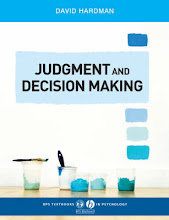Many studies of decision making under risk have described decisions to participants in which the choice is between a certain outcome and a two-outcome gamble of equivalent (or slightly higher) expected value where one of the possible outcomes is zero. Where gains are concerned, people typically prefer sure things to gambles, except where the gamble has a small probability of winning (and hence the outcome is high). The opposite is true where losses are involved: people choose gambles over certain losses, except where the probability of the worst outcome is very small. For decisions involving uncertainty there are no stated probabilities, but when analyses based on people's judged probabilities have shown similar results.
However, other studies have examined how people make decisions about options where they have previously experienced outcomes, but do not know the objective features of the options (a key study is: Hertwig, Barron, Weber, and Erev, 2004). In these studies, participants continually chooose between two unlabeled buttons, where the chosen button delivers an outcome to the participant. After a series of sampling trials, participants are then asked to make a choice between the two buttons. These studies have reported opposite results to those based on described decisions: risk aversion for low probability gains and high probability losses, and risk-seeking for high probability gains and low probability losses. Hertwig et al suggested that two theories of decision making might be necessary to account for the results.
However, according to a new study by Liat Hadar and Craig Fox (2009), a single theory may suffice for both described and experienced decisions. They suggest that the results from the two types of decision may diverge when there is an information asymmetry between them. Notably, in studies of experienced decisions, some participants never experience non-zero outcomes when they select the (unlabelled) button representing binary outcomes where one outcome is infrequent.
In Study 1, Liat and Hadar had 111 participants sample information, but whereas some received information directly in the form of numbers (outcomes), others received symbols (events) and were later told what numbers they represented. During the final choice phase that followed sampling, some participants were shown buttons labelled only with the outcomes/events they had actually experienced, whereas others were provided with labels of all possible outcomes/events. One option always had a slightly higher expected value than the other.
The provision of information as outcomes or events made no difference to people's decisions. However, there was a difference depending on whether people received complete information in the choice phase. Similar choices were made by people who experienced all outcomes/events or who were made aware of all the possibilities: these participants tended to choose the higher expected value button. However, people who did not experience all outcomes/events and were not informed about all possibilities tended to choose the lower expected value button; that is, they tended to underweight low probability options.
In a second study, Hadar and Fox investigated the possibility that always-experienced outcomes are less frequently interpreted as certain when all previous lottery choices have resulted in zero or nonzero outcomes. This was exactly what they found and it could explain why previous studies of decisions from experience have reported risk-seeking behaviour for high-probability gains.
References
Hadar, L., and Fox, C.R. (2009). Information asymmetry in decision from description versus decision from experience. Judgment and Decision Making, 4 (4), 317-325.
Hertwig, R., Barron, G., Weber, E. U., & Erev, I. (2004). Decisions from experience and the effect of rare events in risky choice. Psychological Science, 15, 534–539.
Sunday, 21 June 2009
Subscribe to:
Post Comments (Atom)
About Google Analytics
This website uses Google Analytics, a web analytics service provided by Google, Inc. (“Google”). Google Analytics uses “cookies”, which are text files placed on your computer, to help the website analyze how users use the site. The information generated by the cookie about your use of the website (including your IP address) will be transmitted to and stored by Google on servers in the United States . Google will use this information for the purpose of evaluating your use of the website, compiling reports on website activity for website operators and providing other services relating to website activity and internet usage. Google may also transfer this information to third parties where required to do so by law, or where such third parties process the information on Google's behalf. Google will not associate your IP address with any other data held by Google. You may refuse the use of cookies by selecting the appropriate settings on your browser, however please note that if you do this you may not be able to use the full functionality of this website. By using this website, you consent to the processing of data about you by Google in the manner and for the purposes set out above.




No comments:
Post a Comment